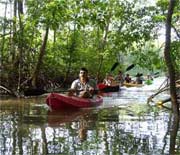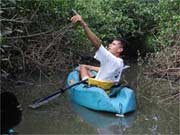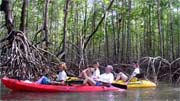|
EXCURSIONS & TOURS
MANGROVES RIO TERRABA - SIERPE
|
The
mangroves in this area are part of the
international Reserve Terraba � Sierpe
Humid Forest. It covers in total 22.000
ha. of mangrove forests and is one of
the biggest mangrove areas in Central
America.
Mangroves are what botanists
call halophytes, plants that thrive
in salty conditions. Although they do
not require salt (they in fact grow
better in fresh water), they thrive
where no other tree can.
|

|
|
Costa
Rica's young rivers have short and violent
courses which keep silt and volcanic
ash churned up and suspended, so that
a great deal of it is carried out of
the mountains onto the coastal alluvial
plains.
|
|
The
nutrient-rich mud generates algae and
other small organisms that form the
base of the marine food chain. Food
is delivered to the estuaries every
day from both the sea and the land so
those few plants--and creatures--that
can survive here flourish in immense
numbers. And their sustained health
is vital to the health of other marine
ecosystems. Mangrove swamps, especially
those fed by freshwater streams, are
marine nurseries of astonishing fertility.
A look down into the water reveals luxuriant
life, large schools of tiny fish cause
the water to ripple as they come to
the surface. Red snapper, grouper, snook,
walleye, shrimp and crabs, spend much
of their early lives among mangrove
roots, shielded by the root maze that
keeps out large predators. There is
even an arboreal mangrove tree crab
(Aratus pisonii) which eats mangrove
leaves and is restricted to the very
crowns of the trees by the predatory
activities of another arboreal crab,
Goniopsis pulcra.
|
|
Many
varieties of aquatic birds are to be
found in the mangroves. Common species
are: reddish and blue egret, white ibis,
kingfishers, ospreys, pelicans, frigates,
tiger and boat-billed herons. Frequently
spotted mammals are the white face,
and squirrel monkeys and the crab eating
Raccoon. Reptiles to be observed are
mostly small constrictor snakes and
young crocodiles (about 2 feet long).
|
|
|
Kayak
tour Mangroves: US $ 50 pp
(appr.
3 hours, minimum 2 persons)
The
Mangrove- Kayak Tour Using short sit-on-top
kayaks quietly travel in the shade of
the Mangrove trees through narrow canals
opened for this tour. No outboard motor
disturbs the tranquil habitat. Duration
of the tour is 3-4 hours.
The
kayak tour leaves only one hour before
high tide, because of the fact that
the tour goes with the flow during this
time.
|


|
The
Grand Terraba River:
The
Grand Terraba River is the largest river in this
country, 198 kilometers long with the biggest volume
of water as well. Descending from the highest point
of Costa Rica, Chirripo National Park (Talamanca
Mounting Range ) down to the Pacific Ocean. This
river its also surrounded by 2 Indians reserves
The Borucas and Terrabas, located by the meddle
length of the river and forms the biggest deltas
and the largest mangrove swamp in this country,
where you can get to identify 9 species of mangrove.
Full
day Kayak
tour River Terraba: US $65 pp
Minimum
of 4 persons.
Your
tour guide will pick you up around 8 am at the hotel
and take you for about an hour South on the coastal
road. Stops will be made wherever you spot birds,
monkeys and sloths. When you arrive at Palmar Norte,
you will get the best quality and safety equipment
there is. A professional kayak instructor will introduce
you to the grand canyon on 15 kilometers, scenery
and the emotion of rapid classes I, II & III.
Down river you will admire the great scenery of
this river with its beautiful vegetation, great
variety of fauna, including: Toucans, Iguanas, Caimans,
monkeys and King Vultures. Spectacular view of mountains.Full
day Tour Kayaking River Terraba, (including
transportation from the hotel lunch, bilingual guide).
|